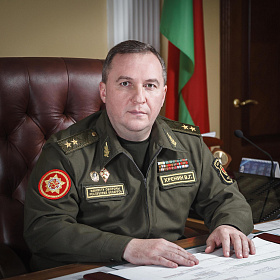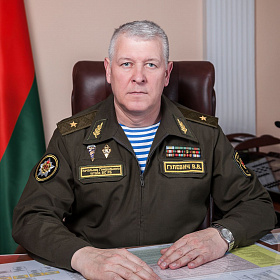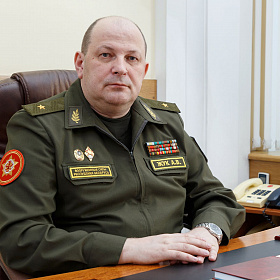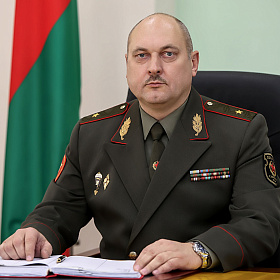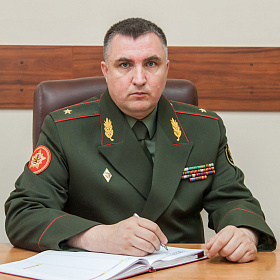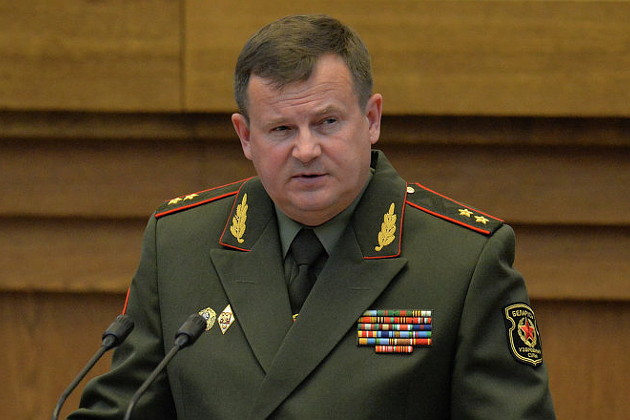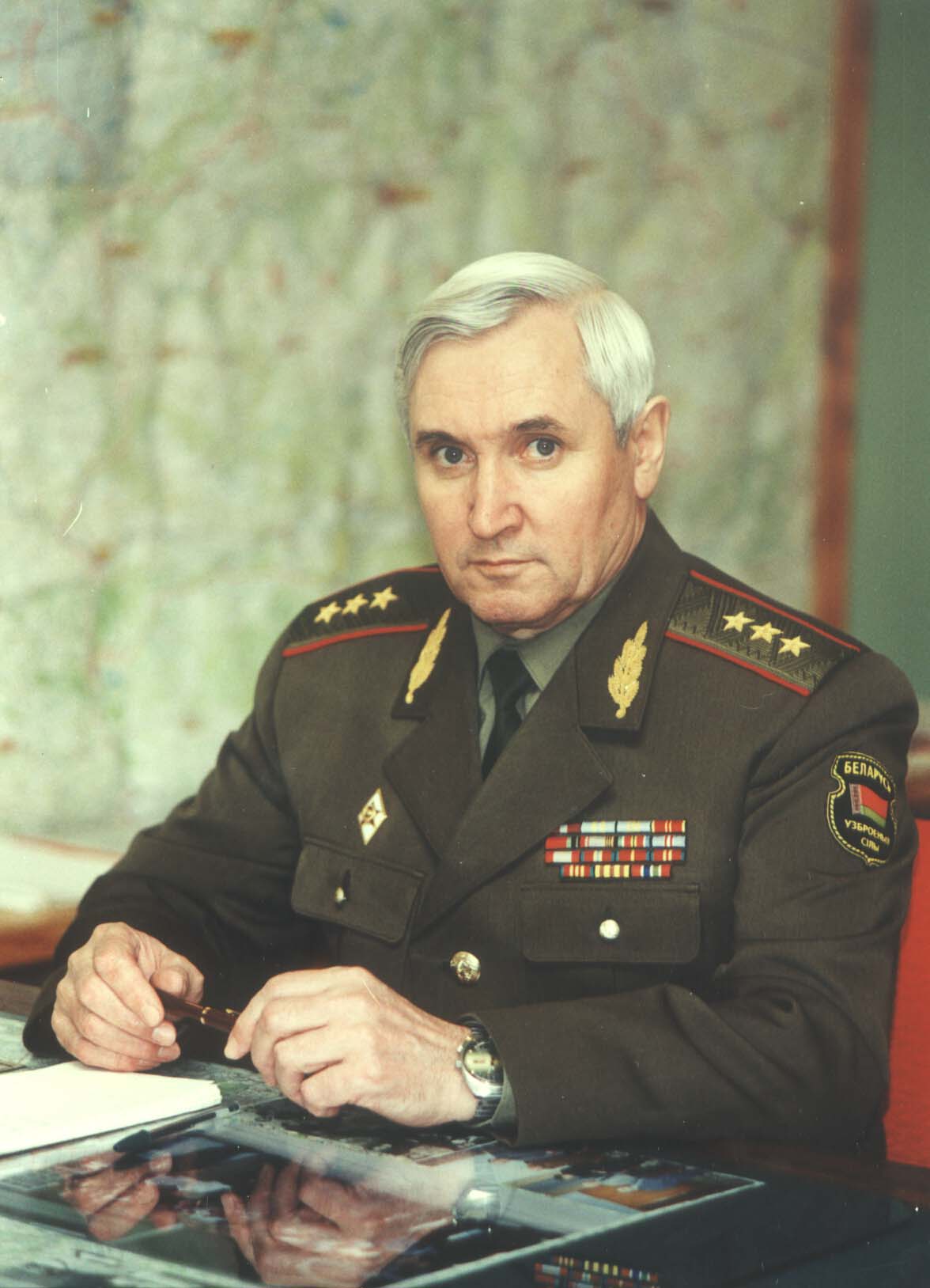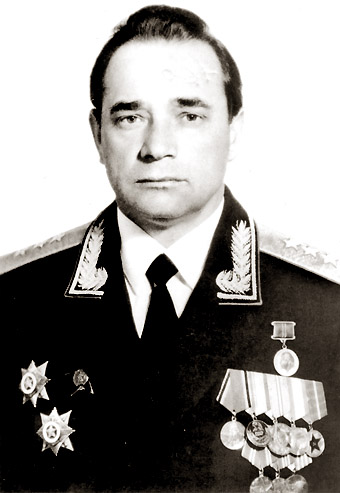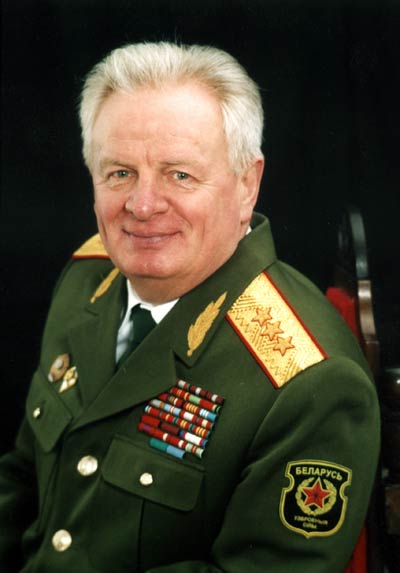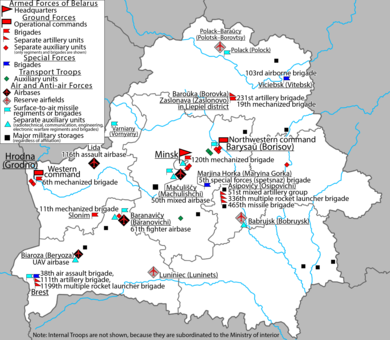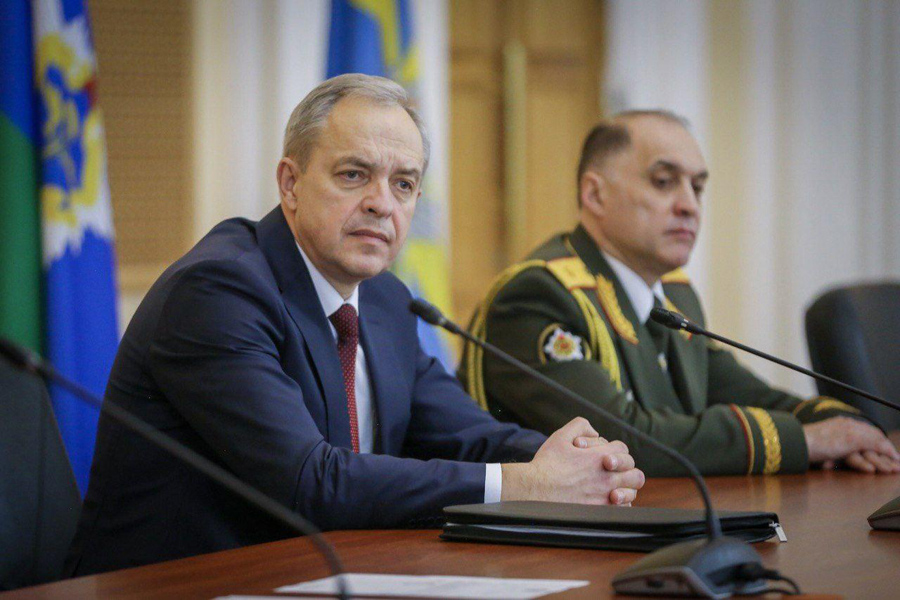Министр обороны Республики Беларусь
Начальник Генерального штаба Вооруженных Сил — первый заместитель Министра обороны Республики Беларусь
Заместитель Министра обороны Республики Беларусь
Заместитель Министра обороны по вооружению — начальник вооружения Вооруженных Сил Республики Беларусь
Заместитель Министра обороны по тылу — начальник тыла Вооруженных Сил Республики Беларусь
На чтение 7 мин Просмотров 5.2к. Опубликовано 20.01.2021
Министерство обороны появилось в нашей стране лишь после обретения самостоятельности — 20 марта 1992 года. До этого наша территория считалась в СССР лишь Белорусским военным округом.
Мы вспомнили, кто за всю историю занимал должность министра обороны.
Посмотреть информацию о других министерствах Беларуси можно по тегу Власть Беларуси
| Министр | Годы руководства министерством |
|---|---|
| Петр Чаус | 1991 — 1992 |
| Павел Козловский | 1992 — 1994 |
| Анатолий Костенко | 1994 — 1995 |
| Леонид Мальцев | 1995 — 1996 |
| Александр Чумаков | 1996 — 2001 |
| Леонид Мальцев | 2001 — 2009 |
| Юрий Жадобин | 2009 — 2014 |
| Андрей Равков | 2014 — 2020 |
| Виктор Хренин | с 2020 года |
Виктор Хренин
(с 2020 года)
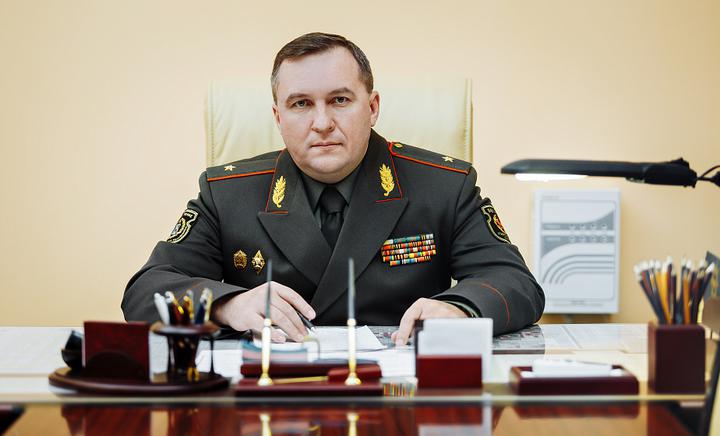
Место рождения (национальность): Новогрудок Гродненской области (беларус)
Образование: Уссурийское суворовское училище, Омское общевойсковое командное училище, Военная академия Беларуси
Воинские заслуги и награды: орден «За службу родине»,
Воинское звание на момент нахождения на должности министра: генерал-лейтенант
Работа до назначения на должность министра: командующий войсками Западного оперативного командования
Чем запомнился: участием вооруженных сил в разгоне мирных акций протеста после президентских выборов 2020 года. А также высказыванием о призыве Тихановской не выступать против мирных граждан: «Эта женщина нас призывает к измене, нарушению закона — не выполнять приказы. Преступный он, не преступный… — мы люди военные»
Андрей Равков
(2014 — 2020)
Год рождения: 1967 (47 лет)
Место рождения (национальность): деревня Ревяки Витебской области (беларус)
Образование: Минское суворовское военное училище, командно-штабной факультет Военной академии Республики Беларусь, Военная академия Генерального штаба Вооружённых сил Российской Федерации
Воинские заслуги и награды: Орден «За службу Родине» III степени
Воинское звание на момент нахождения на должности министра: генерал-лейтенант
Работа до назначения на должность министра: командующий войсками Северо-западного оперативного командования
Куда ушел: возглавил Совет безопасности
Где сейчас: возглавляет Совет безопасности
Чем запомнился: скандалами с дедовщиной в армии
Юрий Жадобин
(2009 — 2014)
Год рождения: 1954 (55 лет)
Место рождения (национальность): Днепропетровск (украинец)
Образование: Казанское высшее танковое командное училище, командный факультет Военной академии бронетанковых войск
Воинские заслуги и награды: Орден Отечества III степени, Орден «За службу Родине» III степени, Орден Дружбы (Россия), Орден Красной Звезды
Воинское звание на момент нахождения на должности министра: генерал-лейтенант
Работа до назначения на должность министра: Государственный секретарь Совета безопасности Республики Беларусь
Куда ушел: уволен в запас в связи с достижением предельного возраста состояния на военной службе
Где сейчас: на пенсии
Леонид Мальцев
(2001 — 2009)
Год рождения: 1949 (52 года)
Место рождения (национальность): деревня Ветеневка Гродненской области (беларус)
Образование: Минское суворовское военное училище, Киевское высшее общевойсковое командное училище, Академия им.М.В.Фрунзе, Военная академия Генерального штаба Вооруженных Сил СССР
Воинские заслуги и награды: Орден Воинской Славы, Орден «За службу Родине» I степени, Орден Дружбы (Россия), орден «За службу Родине в Вооружённых Силах СССР» II и III степени
Воинское звание на момент нахождения на должности министра: генерал-полковник
Работа до назначения на должность министра: заместитель Государственного секретаря Совета Безопасности Республики Беларусь
Куда ушел: Государственный секретарь Совета безопасности Республики Беларусь
Где сейчас: проректор по инновационной и научной работе Международного университета «МИТСО»
Александр Чумаков
(1996 — 2001)
Год рождения: 1941 (55 лет)
Место рождения (национальность): деревня Ильинка Ростовской области (русский)
Образование: Одесское Краснознаменное высшее общевойсковое командное училище, Академия им.М.В.Фрунзе, Военная академия Генерального штаба Вооруженных Сил СССР
Воинские заслуги и награды: ордена «За службу Родине» І степени, орден Красной Звезды, орден «За службу Родине в Вооруженных Силах СССР» ІІ и ІІІ степени
Воинское звание на момент нахождения на должности министра: генерал-полковник
Работа до назначения на должность министра: начальник Главного штаба, первый заместитель Министра обороны Республики Беларусь
Куда ушел: уволен в запас в связи с достижением предельного возраста состояния на военной службе
Где сейчас: на пенсии
Леонид Мальцев
(1995 — 1996)
Год рождения: 1949 (46 лет)
Место рождения (национальность): деревня Ветеневка Гродненской области (беларус)
Образование: Минское суворовское военное училище, Киевское высшее общевойсковое командное училище, Академия им.М.В.Фрунзе, Военная академия Генерального штаба Вооруженных Сил СССР
Воинские заслуги и награды: Орден Воинской Славы, Орден «За службу Родине» I степени, Орден Дружбы (Россия), орден «За службу Родине в Вооружённых Силах СССР» II и III степени
Воинское звание на момент нахождения на должности министра: генерал-полковник
Работа до назначения на должность министра: начальник Главного штаба, первый заместитель Министра обороны Республики Беларусь
Куда ушел: был уволен с должности со скандалом «за проступок, дискредитирующий воинское звание офицера (появление в общественном месте в нетрезвом состоянии)», после этого работал первым заместителем начальника Штаба по координации военного сотрудничества государств—участников СНГ
Где сейчас: проректор по инновационной и научной работе Международного университета «МИТСО»
Анатолий Костенко
(1994 — 1995)
Год рождения: 1940 (54 года)
Место рождения (национальность): —
Образование: Киевское суворовское военное училище, Одесское высшее общевойсковое командное училище, Академия им.М.В.Фрунзе, Военная академия Генерального штаба Вооруженных Сил СССР
Воинские заслуги и награды: Орден Красного Знамени, орден Красной Звезды, орден «За службу Родине в Вооружённых Силах СССР» II и III степени
Воинское звание на момент нахождения на должности министра: генерал-полковник
Работа до назначения на должность министра: начальник Белорусского военного округа
Куда ушел: военный атташе при посольстве Беларуси в Бенилюксе, военный представитель Беларуси в НАТО
Где сейчас: на пенсии
Павел Козловский
(1992 — 1994)
Год рождения: 1942 (50 лет)
Место рождения (национальность): Германия — родился когда вся семья была вывезена немцами (беларус)
Образование: Ташкентское Высшее общевойсковое командное училище, Академия им.М.В.Фрунзе, Военная академия Генерального штаба Вооруженных Сил СССР
Воинские заслуги и награды: —
Воинское звание на момент нахождения на должности министра: генерал-полковник
Работа до назначения на должность министра: начальник штаба, первый заместитель командующего Белорусского военного округа
Куда ушел: председатель Международного фонда реабилитации здоровья бывших военнослужащих
Где сейчас: на пенсии, председатель Международного фонда реабилитации здоровья бывших военнослужащих
Петр Чаус
(1991 — 1992)
Год рождения: 1939 (53 года)
Место рождения (национальность): деревня Старина Гомельской области (беларус)
Образование: Минское суворовское военное училище, Ташкентское Высшее общевойсковое командное училище, Военно-политическая академию им.В.И.Ленина, Военная академия Генерального штаба Вооруженных Сил СССР
Воинские заслуги и награды: служба в Афганистане, два ордена Красной Звезды, орден «За службу Родине в Вооружённых Силах СССР» III степени, два ордена Красного Знамени (Афганистан)
Воинское звание на момент нахождения на должности министра: генерал-полковник
Работа до назначения на должность министра: начальник штаба, первый заместитель начальника Гражданской обороны СССР
Куда ушел: заместитель министра обороны Республики Беларусь, начальник Минского гарнизона
Где сейчас: на пенсии
Самым молодым министром обороны стал в 1995 году Леонид Мальцев — в 46 лет. А самым возрастным в 2009 году Юрий Жадобин — в 55 лет.
Лишь два министра по национальности были не беларусами. Александр Чумаков — русский, а Юрий Жадобин — украинец. Никаких сведений о месте рождения Анатолия Костенко найти не удалось.
Два последних министра, Юрий Жадобин и Андрей Равков были генерал-лейтенантами. Остальные — генерал-полковниками, а Виктор Хренин — генерал-майором.
Леонид Мальцев единственный, кто возглавлял Министерство обороны дважды.
Посмотреть информацию о других министерствах Беларуси можно по тегу Власть Беларуси
https://sputnik.by/20220815/kadrovye-perestanovki-proshli-v-armii-i-oboronke-belarusi-1065812370.html
Кадровые перестановки прошли в армии и «оборонке» Беларуси
Кадровые перестановки прошли в армии и «оборонке» Беларуси
Указом президента сменился начальник Главного штаба ВВС и ПВО, а также руководитель ГВПК. 15.08.2022, Sputnik Беларусь
2022-08-15T20:16+0300
2022-08-15T20:16+0300
2022-08-16T09:59+0300
новости беларуси
безопасность
александр лукашенко
отставки и назначения
министерство обороны беларуси
кадровые решения президента
/html/head/meta[@name=’og:title’]/@content
/html/head/meta[@name=’og:description’]/@content
https://cdnn11.img.sputnik.by/img/07e4/0b/05/1046067979_0:529:590:861_1920x0_80_0_0_7b77e0f04f89d36287c3afda5ab08f2b.jpg
МИНСК, 15 авг – Sputnik. Президент Беларуси Александр Лукашенко провел определенные кадровые перестановки в Вооруженных силах республики и сфере оборонной промышленности, сообщили в пресс-службе главы государства.Документы, которыми на должности назначены новые люди, он подписал в понедельник 15 августа.Так, полковник Сергей Фролов теперь будет руководить Главным штабом и являться первым заместителем командующего ВВС и ПВО.Лукашенко освободил от должности одного из заместителей начальника Генштаба>>>От должности начальника ракетных войск и артиллерии ВС – начальника управления ракетных войск и артиллерии Генштаба освобожден генерал-майор Геннадий Козловский. Он уволен со службы уволен в запас по возрасту. На эту должность назначен полковник Руслан Чехов.От должности первого зама председателя Государственного военно-промышленного комитета освобожден генерал-майор Игорь Демиденко. Он откомандирован в Минобороны и уволен с военной службы в запас по возрасту.>>> Хотите еще больше актуальных и интересных новостей – подписывайтесь на Telegram-канал Sputnik БеларусьТакже на Sputnik:
новости беларуси
Sputnik Беларусь
media@sputniknews.com
+74956456601
MIA „Rosiya Segodnya“
2022
Sputnik Беларусь
media@sputniknews.com
+74956456601
MIA „Rosiya Segodnya“
Новости
ru_BY
Sputnik Беларусь
media@sputniknews.com
+74956456601
MIA „Rosiya Segodnya“
https://cdnn11.img.sputnik.by/img/07e4/0b/05/1046067979_166:485:590:803_1920x0_80_0_0_5f33735baeb9f56e6c994daa3743d63d.jpg
Sputnik Беларусь
media@sputniknews.com
+74956456601
MIA „Rosiya Segodnya“
новости беларуси, безопасность, александр лукашенко, отставки и назначения, министерство обороны беларуси, кадровые решения президента
новости беларуси, безопасность, александр лукашенко, отставки и назначения, министерство обороны беларуси, кадровые решения президента
Кадровые перестановки прошли в армии и «оборонке» Беларуси
20:16 15.08.2022 (обновлено: 09:59 16.08.2022)
Подписаться на
Указом президента сменился начальник Главного штаба ВВС и ПВО, а также руководитель ГВПК.
МИНСК, 15 авг – Sputnik. Президент Беларуси Александр Лукашенко провел определенные кадровые перестановки в Вооруженных силах республики и сфере оборонной промышленности, сообщили в пресс-службе главы государства.
Документы, которыми на должности назначены новые люди, он подписал в понедельник 15 августа.
Так, полковник Сергей Фролов теперь будет руководить Главным штабом и являться первым заместителем командующего ВВС и ПВО.
От должности начальника ракетных войск и артиллерии ВС – начальника управления ракетных войск и артиллерии Генштаба освобожден генерал-майор Геннадий Козловский. Он уволен со службы уволен в запас по возрасту.
На эту должность назначен полковник Руслан Чехов.
От должности первого зама председателя Государственного военно-промышленного комитета освобожден генерал-майор Игорь Демиденко. Он откомандирован в Минобороны и уволен с военной службы в запас по возрасту.
>>> Хотите еще больше актуальных и интересных новостей – подписывайтесь на Telegram-канал Sputnik Беларусь
Белорусские военные завоевали 22 медали на играх в Казахстане
| Armed Forces of the Republic of Belarus | |
|---|---|
| Узброеныя сілы Рэспублікі Беларусь (Belarusian) Вооружённые силы Республики Беларусь (Russian) |
|

Emblem of the Belarusian defense ministry |
|

Flag |
|
| Founded | 1992 |
| Service branches | Transport Troops Territorial Troops |
| Headquarters | Defense Ministry, Minsk, Belarus |
| Website | www.mil.by |
| Leadership | |
| President | |
| Minister of Defense | |
| Chief of the General Staff | |
| Personnel | |
| Conscription | Yes[2] |
| Active personnel | 62,000[3][4] |
| Reserve personnel | 344,750 |
| Expenditures | |
| Budget | €660 million (2020)[5] |
| Percent of GDP | 1.2% (2018) |
| Industry | |
| Domestic suppliers | Belarusian Plant of Precision Electromechanic Kalashnikov |
| Foreign suppliers | |
| Related articles | |
| History | Russo-Ukrainian War |
| Ranks | Military ranks of Belarus |
Map showing main military units of the Belarusian Armed Forces
The Armed Forces of the Republic of Belarus (Belarusian: Узброеныя сілы Рэспублікі Беларусь [УС РБ], romanized: Uzbrojenyja sily Respubliki Bielaruś [US RB], Russian: Вооруженные силы Республики Беларусь, romanized: Vooruzhennyye sily Respubliki Belarus) consist of the Ground Forces and the Air Force and Air Defence Forces, all under the command of the Republic of Belarus Ministry of Defence. Being a landlocked country, Belarus has no navy.
In 2017, IISS estimated that personnel in the armed forces numbered 48,000. Most soldiers are conscripts serving for a period of 18 months, although there is an alternative service option.[6]
Belarus conducted military reforms in the early 2000s which reshaped its armed forces as a relatively effective force for a small state in somewhat difficult economic conditions.[7]
History[edit]
The previous Belarusian People’s Republic of March 1918 to 1919 did not have time to create armed forces in its brief existence, although attempts to create a military have been documented.[8]
Until 1991, the Soviet Belorussian Military District comprised the 5th Guards Tank Army (HQ Bobruisk), the 7th Tank Army (HQ Borisov), the 28th Army (HQ Grodno), the 120th Guards Motor Rifle Division, the 72nd Guards District Training Center and logistical units and formations. Additionally, the Belorussian SSR hosted the 103rd Guards Airborne Division, the 38th Guards Airborne Brigade, the 11th Air Defence Corps of the 2nd Air Defence Army, and the 26th Air Army, as well as units and formations of the Strategic Rocket Forces, Long Range Aviation, the Navy, and special forces.
In late 1991 the 5th Guards Tank Army comprised the 30th Guards Motor Rifle Division, newly arrived from Czechoslovakia, and the 193rd Tank Division, plus two armament and equipment storage bases (the former 8th Guards and 29th Tank Divisions), and army troops. The 7th Tank Army comprised the 3rd Guards Tank Division, 34th, and 37th Guards Tank Divisions, plus army troops. The 28th Army comprised two divisions, the 6th Guards Tank and 50th Guards Motor Rifle, the 6314th Equipment Storage Base at Slonim, and the 5356th Base for Storage of Weapons and Equipment, formerly a low-status mobilisation division.[9] Also arriving from the Southern Group of Forces in Hungary was the 19th Guards Tank Division.
On September 20, 1991, the Supreme Soviet of Belarus passed resolution «On the formation of the Armed Forces of the Republic of Belarus» and on January 11, 1992, resolution «On the Armed Forces deployed in the territory of the Republic of Belarus.» On March 18, 1992, the parliament passed resolution «On the Armed Forces of the Republic of Belarus» that bound the government «to start the formation of the Armed Forces of the Republic of Belarus as of March 20, 1992» and «to submit to the Supreme Soviet for approval the suggested structure of the Armed Forces, their size and order of their material and technical supplies».
On May 6, 1992, the Belorussian Military District was abolished. The Belarusian Ministry of Defence and the Main Staff were formed from its resources.[10] The former first deputy commander and military district Chief of Staff, Lieutenant-General Pavel Kozlovskiy, was appointed Minister of Defence on 22 April 1992, taking over from acting Minister of Defence Colonel-General Petr Chaus. On 8 September 1992, the Minsk Higher Military Engineering School and the Minsk Higher Military Command School (now the unified Military Academy of Belarus) were the first to take the military oath of allegiance to the armed forces, with their induction ceremony being held on Independence Square in the presence of defense minister Kozlovskii.[11][12] This was done to commemorate anniversary of the Lithuanian-Polish victory at the Battle of Orsha, which was considered to be a Day of Belarusian Military Glory.[13]
On August 17, 1992, personnel from the United States Department of Defense made a Conventional Forces in Europe Treaty inspection of an installation in Urechye (near Minsk). The 969th Central Base for Reserve Tanks, and two elements of the 30th Guards Motor Rifle Division: the 30th Guards Tank Regiment and the 20th independent Reconnaissance Battalion were the three units at the site.[14]
On November 3, 1992, Belarus passed the law «On the Armed Forces of the Republic of Belarus» defining the status, structure and guiding principles of the Armed Forces.[15] After the introduction of presidency the law was amended twice: on September 4, 1996, and on November 9, 1999, but on the whole the law retains its initial contents.
On January 1, 1993, all service personnel on Belarusian soil were required to either take an oath of loyalty to Belarus, or leave. This oath however did not alleviate concerns regarding loyalty to Russia in time of crisis, especially since nearly 50% of all military personnel were ethnically Russian in the end of 1992.
In June 1995, President Alexander Lukashenko issued a decree on the Mobile Forces. By June 1996, they comprised a headquarters in Vitebsk, two brigades drawn from the 103rd Guards Airborne Division, the 38th Independent Mobile Brigade (Brest, Belarus), an air transport regiment, and communications, logistics, and engineer units.[16]
Membership in the Commonwealth of Independent States, as well as the 1996 treaty on the Union of Russia and Belarus and the Treaty of the Formation of a Union State in 1999, confirmed a close partnership with Russia. Much of the air defence system was integrated into the Russian air defence network, and in 2006 the two nations signed an agreement on the creation of a unified air defence system.[17]
Structure[edit]
Belarus government websites say that the Ministry of Defence of the Republic of Belarus is supported by Central Command Support Elements and the General Staff of the Armed Forces.[18]
Combat Support Elements of the Armed Forces included Reconnaissance, Electronic Warfare, Signals, Engineer, NBC Defence, Navigation and Topography, and Maintenance organisations. Logistic Elements of the Armed Forces provided Material Support, Logistic Support, Medical Support, Veterinarian Support, and Military Construction.
In 1995 the Military Academy of Belarus was set up on the basis of two military educational institutions – the Minsk Air Defence and Rocket School of the Soviet Air Defence Forces and the Minsk Higher Military Command School. Its 10 departments train officers of 38 specialties for practically all arms of service. Also in 1995 it was given the status of a government institution of secondary special military education for young men.
Branches[edit]
Ground Forces[edit]
Combat brigades of Belarus
Source [1]
A Library of Congress study of national ground forces said that in 1994 Belarus had ground forces of 52,500.[19] They were organized into three corps headquarters, two motor divisions, one airborne division, the 51st Guards Artillery Division at Osipovichi,[20] three mechanized divisions, one airborne brigade, three surface-to-surface missile brigades,[21] two antitank brigades, one special duties brigade, and seven anti-aircraft missile brigades. Equipment included 3,108 main battle tanks (seventy-nine T-54, 639 T-55, 291 T-62, 299 T-64, eight T-80, and 1,800 T-72), 419 medium-range launchers, sixty surface to-surface missiles, and 350 surface-to-air missiles.
In 1993 the 7th Tank Army was reorganised as the 7th Army Corps. In 1994 the 7th Army Corps was redesignated as the 65th Army Corps, still located at Borisov.
By January 1, 1995, the composition of the Belarusian ground forces had changed.[19] The Library of Congress study estimated at the time that Ministry of Defence forces included the 103rd Guards Airborne Division and the 38th Separate Assault-Landing Brigade; the 28th Army Corps (Grodno Region and Brest Region), composed of headquarters at Grodno, the 6th Guards Kiev-Berlin Mechanised Brigade, the 11th Guards Mechanised Brigade, the 50th Separate Mechanised Infantry Brigade, the Armament and Equipment base, and corps units (missile troops, antiaircraft, chemical and engineer troops, signals, and rear services); the 65th Army Corps (Minsk and Vitebsk Regions), composed of headquarters at Borisov, three armament and equipment bases, and corps units; and the 5th Guards Army Corps (Minsk and Mahilyow regions) made up of headquarters at Babruysk, the 30th Separate Motor Rifle Brigade, two Armament and Equipment bases, and corps units.
Actually, the 103rd Guards Airborne Division had been reorganized as Headquarters, Mobile Forces, in 1993.
On 1 August 1996 the 51st Guards Artillery Division was reorganised as the 51st Guards Central Group of Artillery, still located at Osipovichi.[22]
On 21 December 2001, a major reorganisation of the Ground Forces produced two operational-territorial commands, formed from two former corps headquarters.[23] All Belarus ground forces were now grouped within these two commands, the Western Operational Command at Grodno, former from the previous 28th Army Corps, the former Soviet 28th Army, and the North Western Operational Command, the former 65th Army Corps, at Barysaw (Borisov).
Since about 2001, territorial defence forces, which as of 2002 number around 150,000, have been forming, organised into battalions, companies, and platoons spread across Belarus.[23]
In 2007, the Land Forces consisted of 29,600 soldiers (6th Guards Mechanised Brigade (Grodno), 11th Guards Mechanized Brigade at Slonim, the 120th Guards Mechanised Brigade (Minsk), 38th and 103rd Mobile Brigades (organized similarly to Soviet airborne regiments, not all of them are equipped with BMD-1),[24] 5th Spetsnaz Brigade (Maryina Horka),[25] five artillery brigades and four regiments, two MRL regiments, 15th, 29th, 115th, 120th and 302nd SAM Brigades, two SSM brigades, two brigades and one regiment of engineers, 8th independent NBC Brigade, two signals brigades, 40th independent NBC battalion. Army equipment includes 1800 main battle tanks (MBT) and 2600 AFV/APC. The weapons and equipment storage bases include the 50th (Brest), 19th,[26] 34th & 37th (former tank divisions), 3rd, and 28th (Baranovichi). Weapons storage bases that have been disbanded include the 29th, 30th, 193rd, and the storage base that used to be the 8th Guards Tank Division at Marina Gorka.
In 2012 it was reported that there were six mechanised brigades in the Ground Forces: three full-strength, the 6th (Grodno), 11th (Slonim), and 120th Guards Mechanised Brigade at Minsk. The others were at reduced strength, where there was one battalion, the 19th (Zaslonova), 37th, and 50th (Baranovichi).[27] By 2017, the number of mechanised brigades had been further reduced to four, with two at full strength and two at reduced strength.[6]
Air Force and Air Defence Forces[edit]
In 2007 the Air Force and Air Defence Force of Belarus (AF & ADF) consisted of 18,170 personnel (two fighter/interceptor bases, four FGA/reconnaissance squadrons, one transport air base, training aircraft, and attack and support helicopters, SAM units). Air Force equipment included in 2004 260 fighter-ground attack/training aircraft and 80 attack helicopters. According to Belarus government websites, the Air Forces now have two commands, the Western Operational-Tactical Command and the North-Western Operational-Tactical Command.
The 61st and 927th Air Bases have now merged into the 61st (fighter) Air Base at Baranovichi, flying MiG-29s, and the 206th Air Base (Ross) has merged into the 116th Guards Assault Air Base at Lida, flying Su-25s.
Independent forces[edit]
Special Forces[edit]
The Special Forces of Belarus is the airmobile and strategic deterrence force. It has been a participant in conflicts such as the United Nations Interim Force in Lebanon[28] and the Libyan Civil War (2011).[29]
Transport Troops[edit]
The Belarusian Transport Troops is responsible for the movement of personnel and material by truck, rail, and air. It is also designed to carry the tasks of the transport support of the military formations from other service branches. General leadership is exercised by the Minister of Defense, while direct control is carried out by the Head of the Transport Support Department, a position that reports directly to the President.
Territorial Forces[edit]
The Territorial Forces (Belarusian: Тэрытарыяльныя войскі, Russian: Территориальные войска) are a homeland defence organization in the armed forces. It is managed by the Department of the Territorial Forces, being a support department of the Ministry of Defence of Belarus and is operated by the General Staff. It is currently located on Kommunisticheskaya Street in Minsk. The current head of the department of territorial forces is Colonel Andrei Paseko. The Territorial Defence system was established in the early 2000s. Over 120,000 troops constitute the size of the Territorial Forces, which is twice as much as it serves in the regular duty military.[30] During an address by President Alexander Lukashenko on 18 February 2016, he announced the allocation of arms and to the territorial forces and the minimum and maximum amount of district troops ranging from one company and a battalion. Personnel of these units are recruited from residents of their respective administrative-territorial regions.[31][32][33][34][35]
Specialized forces[edit]
Special troops are designed to support the combat activities of the Ground Forces and solve their inherent tasks. They include formations and military units of intelligence, communications, engineering, radiation, chemical and biological defense, electronic warfare, navigation and topographic.[36]
- Electronic Warfare Troops
- Signal Corps
- Engineer troops
- NBC Protection Troops
- Topographic Navigation Service
Security forces[edit]
Internal Troops[edit]
The Special Purpose Unit of the Internal Troops.
The Internal Troops of Belarus were formed from the former Soviet Internal Troops after the collapse of the Soviet Union. They consist of three independent brigades and seven independent battalions (consecutively numbered).
Border Guard Service[edit]
The Border Guard Service is the paramilitary force of the State Border Committee of the Republic of Belarus. It covers the borders with Russia, Ukraine, Poland, Lithuania and Latvia.[37][38]
Manpower[edit]
Belarusian jets during a flyby in Minsk, July 2019.
The Government Directive of 20 March 1992 ‘On the Establishment of the Armed Forces of the Republic of Belarus’ founded the Belarusian army. The Soviet troops of the BMD were smoothly converted into Belarusian military units. Yet one of the first tasks of the Belarusian government was a reduction in its numbers. 240,000 soldiers and officers were serving in the Belarusian Military District. By early 2013 the numbers of military personnel had been scaled down nearly fourfold since 1991. In February 2014, Belorusskaya Voyennaya Gazeta, the official publication of the Ministry of Defense revealed that the Belarusian Armed Forces contains about 59,500 personnel, including 46,000 soldiers and 13,000 civilians.[39]
Personnel[edit]
Military commandants[edit]
The military commandants of the Armed Forces of Belarus are regional administrations tasked with overseeing Belarusian regiments in the commandant’s territory. Units are assigned to a specific commandant based on their location. There are 6 military commandants in the Belarusian Armed Forces.[40]
| Commandant Name | Commander | Region |
|---|---|---|
| Belarus Supreme Commander | Supreme Commander Alexander Lukashenko | All Regions |
| Baranavichy Military Commandant | Lieutenant Colonel Vladimir Pivovar | Brest Region |
| Babruysk Military Commandant | Lieutenant Colonel Vladimir Gritsuk | Mogilev Region |
| Barysaw Military Commandant | Lieutenant Colonel Ivan Kislyi | Minsk Region |
| Brest Military Commandant | Lieutenant Colonel Yuri Ivanyuk | Brest Region |
| Grodno Military Commandant[41] | Lieutenant Colonel Alexander Lupyrev | Grodno Region |
| Minsk Military Commandant | Colonel Nikolai Kurash | Minsk Region |
Units under the command of commandants include military police, honour guards and military bands.[42]
Military education[edit]
- Military Academy of Belarus
- Ministry of the Interior Academy of Belarus
- Border Guard Service Institute of Belarus
- Military Institute of the Belarusian State Medical University[43]
- Military Faculty of the Belarusian State University – The faculty was established on 4 November 1926, by order of the Revolutionary Military Council. In 1941, at the beginning of the Great Patriotic War, military training classes were interrupted only to be resumed in 1943. In the post-war and subsequent years, the military department continued to train reserve officers from among the students in the required military accounting specialties. In 2003, the military department was reorganized into the modern military faculty of Belarusian State University.[44]
- Military Faculty of the Belarusian State University of Informatics and Radioelectronics
- Military Faculty of the Belarusian National Technical University
- Military Faculty of the Grodno State University
- Military Faculty of the Belarusian State University of Transport
- Military Faculty of the Belarusian State Academy of Aviation
Equipment[edit]
The military forces of Belarus are almost exclusively armed with Soviet-era equipment inherited from the Soviet Union. Although large in numbers, some Western experts consider some of it outdated.
«The Belarusian armed forces receive around 100 brand-new and upgraded systems a year», said in late July 2018, Belarusian Deputy Minister of Defence for Armament and Chief of Armament Major General Sergei Simonenko.[45] The MBTs are of Russian type T-72, T-62, and T-55, the APCs and IFVs are of Russian type MT-LB, BMP-2, BMP-1, and the BMD-1, and Russian type trucks are the GAZ-66 and the KAMAZ-6560.
While the IISS Military Balance 2016 listed 69 T-80s in service,[46] by 2018 the listing had been removed, and the only MBTs listed were 527 T-72 as well as 5 T-72B3.
The Air Force is equipped with MiG-29 fighters, Su-25 attack aircraft, as well as Mi-8, Mi-24, and some old, Polish built Mi-2 helicopters. In December 2005, Belarus bought 10 L-39C jet trainer aircraft from Ukraine, and in 2017 a contract have been signed to buy 12 Su-30SM fighters.[47] In 2006, four batteries (divizions in Russian terminology; about six systems each) of S-300 anti-aircraft systems were acquired from Russia to reinforce the Joint CIS Air Defense System. The Military Balance 2018 listed a brigade with the S-300P and a brigade with the S-300V (SA-12A Gladiator/SA-12B Giant).[48] Moscow and Minsk signed contracts in 2021 for the supply of fighters, helicopters, air defense systems and other weapons to Belarus.[49] S-400 air defense systems and 9K720 Iskander tactical ballistic missiles were delivered in 2022.[50] It was also reported that almost every company was equipped with quadcopters.[51]
Military cooperation[edit]
CSTO[edit]
The armed forces took part in a joint CSTO military intervention in Kazakhstan during the 2022 Kazakh unrest.[52][53]
Military advisors[edit]
The armed forces have sent their military specialists to countries such as Côte d’Ivoire, Venezuela, Libya, Yemen and the Democratic Republic of the Congo, acting both officially and secretly. In Belarus, they have previously trained military personnel from the Nigerian Army. In 2014 and 2015, the special forces of the Nigerian Army were trained on the territory of Belarus, with the Belarusians training the Nigerians in counterterrorism.[54][55]
In 2007, an agreement was signed in Caracas with Venezuela, according to which Belarusian military specialists for the National Bolivarian Armed Forces of Venezuela were developing a unified air defense and electronic warfare system.[56] The following year, the first ten servicemen went to the country, with Lieutenant-General Oleg Paferov being appointed as the officer responsible for the activities of the advisers.[57] A contingent of about 500 military advisers was also present in Libya during the First Libyan Civil War, supporting the government of Muammar Gaddafi.[29] As of autumn 2013, there were at least two Belarusian advisers in Yemen at the Ministry of Defense. On November 26 of the same year, during an attack on a hotel in Sana’a, a Belarusian was killed and another was wounded.[58] In February 2020, a dozen Belarusian military instructors arrived in Abidjan (Côte d’Ivoire), where they were stationed at the Agban military base, which is occupied by one of the country’s national gendarmerie units.[59]
Institutions and special units of the armed forces[edit]
Museum of Military History of Belarus[edit]
The Museum of Military History of Belarus (Russian: Музей военной истории Беларуси) is located in the Pyershamayski District of Minsk.[60] It was established as the Museum of the History of the Belarusian Military District, opened in Minsk on February 21, 1978. In July 1993, it was converted into a museum on the military history of Belarus. The exhibits are the same as before the collapse of the USSR, with a small section on the medieval history of the Grand Duchy of Lithuania having since been added.[61] Its collection numbers over 18 thousand exhibits. The most ancient of them date back to the 6th century.[62]
Drama Theatre of the Belarusian Army[edit]
Belarusian Union of Officers[edit]
The Public Association «Belarusian Union of Officers» (hereinafter referred to as BSO) is a public association of officers and warrant officers who are on active duty and in retirement. It was established on 20 September 1992 at its founding congress. On September 18, 1993, Deputy of the Supreme Soviet Alexander Lukashenko took part in the 2nd Congress. From October 2005 to January 2015, the Republican Council of the BSO was headed by retired Lieutenant General E. Mikulchik, and until November 2017 was led by retired Major General V. Bamburov.[63]
Other[edit]
- Military Band Service of the Armed Forces
- Belarusian Armed Forces Academic Song and Dance Ensemble
- Central House of Officers (Minsk)
- Honor Guard of the Armed Forces of Belarus
- Belarusian Great Patriotic War Museum
- Belaya Rus demonstration team
Military holidays[edit]
- In Belarus, the holiday annual Defender of the Fatherland Day (known as Дзень абаронцы Айчыны in the Belarusian language) celebrations on 23 February also coincide with the Day of the Armed Forces (Дзень Узброеных Сіл). It commemorates that day 1918 when the first unified military in the country was established as part of the Red Army. Officially declared a public holiday by President Lukashenko on 25 March 2004, it has traditionally been honoured with a wreath laying ceremony by the President of Belarus on Victory Square. Joint festive events with soldiers of the Russian Armed Forces soldiers are also hold on 23 February in connection with their professional holiday. During the centennial of the armed forces in 2018, events were held throughout the year, including a military parade in Gomel and celebrations in Vitebsk.[64][65][66]
- Although a national holiday, Independence Day is primarily an armed forces celebration which honours those who took part in the Red Army’s 1944 Minsk Offensive. The Minsk Independence Day Parade is the main military event done on this day.
Combat Banners and military marches[edit]
The Battle Banner of a military unit is a symbol of the unit, retained throughout its lineage. Changes in the name and numbering of a military unit are entered in the Certificate of the President of the Republic of Belarus, issued upon presentation of the Battle Banner. The Battle Banner is awarded to formations, brigades/regiments, battalions, divisions, air squadrons, training units, and military educational institutions. Guards units are awarded with a black-and-orange guards ribbon attached to its shaft. Upon presentation of the Battle Banner to a military unit, a Diploma of the President of the Republic of Belarus is issued. In the event of the loss of the Battle Banner, the commander of a military unit and its servicemen are subject to legal consequences and the military unit is disbanded.[67]
The following is a list of notable Belarusian military pieces:[68][69]
- Motherland My Dear (Радзіма мая дарагая)
- Victory March (Марш Перамогi)
- Anthem of the Military Academy (Гимн Военной академии)
- Grenadier March (Марш Грэнадыі)
- Our Fatherland’s Flag (Айчыны нашай сцяг)[70]
- Song from 45 (Письмо из 45-го)
References[edit]
- ^ «Сухопутные войска Республики Беларусь — Армия Беларуси». belarmy.by. Archived from the original on 2018-04-13. Retrieved 6 April 2018.
- ^ «Belarus announces draft for military training in March».
- ^ «В белорусской армии служит 62 тысячи человек». Archived from the original on 2014-12-24. Retrieved 23 December 2014.
- ^ «Armed forces — Belarus». Archived from the original on 2014-10-28. Retrieved 23 December 2014.
- ^ «Belarus — Government Defence expenditure». Archived from the original on June 27, 2014. Retrieved 2018-05-17.
- ^ a b «The Military Balance 2017». The Military Balance. 117: 203–204. 2017 – via Taylor and Francis.
- ^ Dr Steven J Main, The Belarusian Armed Forces: A Military-Political History 1991–2003 Archived 2008-03-06 at the Wayback Machine, Conflict Studies Research Centre, RMA Sandhurst, 2003.
- ^ «Selected Bibliography of works on the struggle for Belarusian Independence 1900–1921 in the Francis Skaryna Belarusian Library in London». Archived from the original on September 27, 2013. Retrieved May 22, 2020.
- ^ Michael Holm, 76th Tank Division
- ^ I N Rodionov, ed, Belorusskiy voyennyy okrug, Military Encyclopedia, t1, «Voyennoye izdatel’stvo», Moscow, 1997, 422, cited in Main, 2003, 6.
- ^ Archived at Ghostarchive and the Wayback Machine: «Присяга на Площади Независимости! Минск 06 сентября 1992 г.» YouTube.
- ^ «День, когда Площадь была заполнена солнцем и народом».
- ^ «Белорусские офицеры присягнули на верность Родине».
- ^ Harahan, Joseph P.; Kuhn, John C. «On-Site Inspections Under the CFE Treaty, A History of the On-Site Inspection Agency and CFE Treaty Implementation, 1990-1996 (Chapter 6)». nuke.fas.org. Retrieved 2022-04-24.
- ^ Pavel Bykovsky & Alexander Vasilevich, Military Development and the Armed Forces of Belarus Archived 2007-12-05 at the Wayback Machine, Moscow Defence Brief, CAST, 2007
- ^ Richard Woff, ‘Minsk: making limited progress with reform,’ Jane’s Intelligence Review, June 1996, 248.
- ^ Russia, Belarus to sign agreement on joint air defence system Archived 2009-02-12 at the Wayback Machine, RIA Novosti via GlobalSecurity.org, 19 October 2006.
- ^ «Ministry of Defence of RB — News». Archived from the original on 2 May 2006. Retrieved 23 December 2014.
- ^ a b Library of Congress Country Studies, Ground Forces, in A Country Study: Belarus, June 1995
- ^ Feskov et al. 2004, 53, with five artillery brigades and two independent battalions.
- ^ Including the 43rd (OTR-21 Tochka) and 76th (8 НУ 9КЛг) Rocket Brigades at Zaslonovo, probably.
- ^ Soldat.ru, Brigades of the Belarus Armed Forces Archived 2013-01-17 at the Wayback Machine, accessed December 2012.
- ^ a b Main, 2003
- ^ «Вооруженные силы Республики Беларусь». www.ryadovoy.ru. Archived from the original on 2012-04-17.
- ^ Formed Maryina Gorka, Minsk Oblast, 1 January 1963as the 5th Special Forces Brigade GRU. Two battalions. On 3.4.78 renamed 5th independent Special Forces Brigade GRU. Took the oath of allegiance to Belarus on 31 December 1992. Michael Holm, 5th independent Special Forces Brigade Archived 2014-02-02 at the Wayback Machine, accessed 2014.
- ^ One of the equipment storage bases is the 19th, the former 19th Guards Tank Division at Zaslonovo in the Lepiel region. On October 1, 2003, the base was considerably strengthened. From other bases of storage of arms and techniques now we are distinguished favorably by new structure. Besides a battalion of protection, storage and service, motor-rifle and tank battalions were added. «Force _sng». Archived from the original on 2008-05-13. Retrieved 2008-02-10..
- ^ Vad777
- ^ «Кто такие белорусские миротворцы, как они могут появиться в чужой стране и можно ли им стрелять?». TUT.BY. Dec 5, 2017. Archived from the original on September 24, 2020. Retrieved May 22, 2020.
- ^ a b На стороне Каддафи воюют белорусские партизаны[permanent dead link] — Комсомольская правда, 6 апреля 2011
- ^ «Территориальная оборона в системе национальной безопасности — Военный информационный портал Министерства обороны Республики Беларусь». Archived from the original on 2019-07-11. Retrieved 2019-07-11.
- ^ «Strengthening Territorial Defence, New Military Priorities, NATO Dialogue – Belarus Security Digest | BelarusDigest».
- ^ «Территориальные войска сегодня» (PDF). Archived from the original (PDF) on May 16, 2018. Retrieved May 22, 2020.
- ^ «Законы Республики Беларусь о защите республики». lektsii.org. Retrieved May 22, 2020.
- ^ «Войска территориальной обороны (ТерО) Республики Беларусь». www.modernarmy.ru. Retrieved May 22, 2020.
- ^ «Blogger». accounts.google.com. Retrieved May 22, 2020.
- ^ «Специальные войска — Военный информационный портал Министерства обороны Республики Беларусь». www.mil.by. Archived from the original on May 28, 2020. Retrieved May 22, 2020.
- ^ «State Border Committee». Gpk.gov.by. Archived from the original on 13 December 2018. Retrieved 23 January 2019.
- ^ «Taras Seredyuk, the State Border Committee of the Republic of Belarus». rovienna.iom.int. Dec 8, 2017. Archived from the original on March 22, 2019. Retrieved May 22, 2020.
- ^ «ВООРУЖЕННЫЕ СИЛЫ РЕСПУБЛИКИ БЕЛАРУСЬ НА СОВРЕМЕННОМ ЭТАПЕ РАЗВИТИЯ — Во славу Родины». vsr.mil.by (in Russian). Archived from the original on 2018-01-15. Retrieved 2018-01-14.
- ^ «Военные комендатуры Вооруженных Сил — Военный информационный портал Министерства обороны Республики Беларусь». Archived from the original on 2018-05-19. Retrieved 2018-05-18.
- ^ «Добились лучших результатов — Военный информационный портал Министерства обороны Республики Беларусь». www.mil.by. Archived from the original on 2021-05-03. Retrieved 2021-05-03.
- ^ «Парады и порядок — Газета «Минский курьер»«. Retrieved May 22, 2020.
- ^ «Военно-медицинский институт открылся в БГМУ». www.belta.by (in Russian). 2021-06-07. Retrieved 2021-07-11.
- ^ «О Факультете — Военный информационный портал Министерства обороны Республики Беларусь». www.mil.by. Archived from the original on December 8, 2020. Retrieved May 22, 2020.
- ^ «Belarus re-arms airborne troops | Jane’s 360». Archived from the original on 2018-08-08. Retrieved 2018-08-08.
- ^ International Institute for Strategic Studies (IISS) (9 February 2016). «The Military Balance 2016». The Military Balance. 116: 181–183. doi:10.1080/04597222.2016.1127558.
- ^ «On the purchase of Su-30SM for the Belarusian Air Force». 20 June 2017. Archived from the original on 2018-07-23. Retrieved 23 July 2018.
- ^ IISS Military Balance 2018, p.186.
- ^ «ЦАМТО / / Москва и Минск подписали в 2021 году контракты на поставку авиатехники и средств ПВО».
- ^ «ЦАМТО / / Александр Лукашенко: в Белоруссии поставлены на боевое дежурство ЗРС С-400 и ОТРК «Искандер»».
- ^ «Russian instructors with combat experience train Belarusian forces in drone operation».
- ^ Pannier, Bruce (6 January 2022). «Analysis: The Consequences Of Inviting Russian-Led CSTO Troops Into Kazakhstan». RFE/RL. Archived from the original on 7 January 2022.
Russia is reportedly sending 3,000 soldiers to Kazakhstan, Belarus some 500, Tajikistan 200, and Armenia 70, with Kyrgyzstan set to decide on January 7.
- ^ «Миротворческая рота 103-й воздушно-десантной бригады ССО вылетела в Казахстан». Belteleradio. 6 January 2022. Archived from the original on 7 January 2022.
- ^ Нигерийские солдаты проходят специальную подготовку в Беларуси для борьбы с боевиками в дельте Нигера Archived 2018-07-16 at the Wayback Machine — Центр специальной подготовки Республики Беларусь
- ^ Военнослужащие специальных сил Нигерии проходят обучение в Республике Беларусь (Фото)
- ^ Небо над Венесуэлой будет охранять белорусская система ПВО[permanent dead link]
- ^ Полетели шапки военных и пограничников
- ^ Военные, которые пострадали в Йемене, работали по белорусскому контракту Archived 2019-01-20 at the Wayback Machine // TUT.BY (27 ноября 2013)
- ^ Инструкторы из Беларуси прибыли в Кот-д’Ивуар для обучения местных жандармов
- ^ «Государственный музей военной истории Республики Беларусь — Администрация Первомайского района г. Минска». pervadmin.gov.by. Retrieved 2021-05-31.
- ^ «Государственный музей военной истории Республики Беларусь». www.kpopov.ru. Retrieved 2021-05-31.
- ^ «Музей военной истории». Минск старый и новый (in Russian). Archived from the original on 2021-05-23. Retrieved 2021-05-31.
- ^ «Общественное объединение «Белорусский союз офицеров» — Военный информационный портал Министерства обороны Республики Беларусь». www.mil.by. Archived from the original on 2021-05-17. Retrieved 2021-05-31.
- ^ «ВИДЕО. Военный парад к 100-летию Вооружённых Сил Республики Беларусь. Гродно, 23 февраля 2018 года». YouTube. Archived from the original on 2021-11-23. Retrieved May 22, 2020.
- ^ «День защитников Отечества и Вооруженных Сил Республики Беларусь — Военный информационный портал Министерства обороны Республики Беларусь». www.mil.by. Archived from the original on October 7, 2020. Retrieved May 22, 2020.
- ^ «День вооружения Вооруженных Сил — Военный информационный портал Министерства обороны Республики Беларусь». www.mil.by. Archived from the original on February 4, 2021. Retrieved May 22, 2020.
- ^ «Боевое Знамя воинской части — Военный информационный портал Министерства обороны Республики Беларусь». www.mil.by. Archived from the original on September 5, 2019. Retrieved 2021-05-30.
- ^ «StackPath». belsat.eu. Retrieved May 22, 2020.
- ^ «Военные песни — Военный информационный портал Министерства обороны Республики Беларусь». www.mil.by. Archived from the original on May 28, 2020. Retrieved May 22, 2020.
- ^ «Айчыны нашай сцяг». vuchoba.org. Archived from the original on July 2, 2019. Retrieved May 22, 2020.
External links[edit]
- Official website of the Belarusian defense ministry Archived 2019-06-05 at the Wayback Machine
Сегодня Глава Администрации Президента Республики Беларусь Игорь Сергеенко представил руководящему составу Вооруженных Сил министра обороны Республики Беларусь генерал-майора Виктора Хренина и начальника Генерального штаба Вооруженных Сил генерал-майора Александра Вольфовича, сообщает пресс-служба Минобороны.
Представляя должностных лиц, Глава Администрации напомнил: «Глава государства особо подчеркнул, что оба назначенных руководителя знают жизнь армии не понаслышке, люди «одного калибра», прошли все ступени от командиров взводов, ротное звено, батальонное и так далее. За плечами их высокий уровень теоретической подготовки. У каждого колоссальный опыт командования частями и подразделениями, опыт штабной работы. Это профессионально подготовленные, грамотные командиры, способные масштабно мыслить и организовывать служебную деятельность».
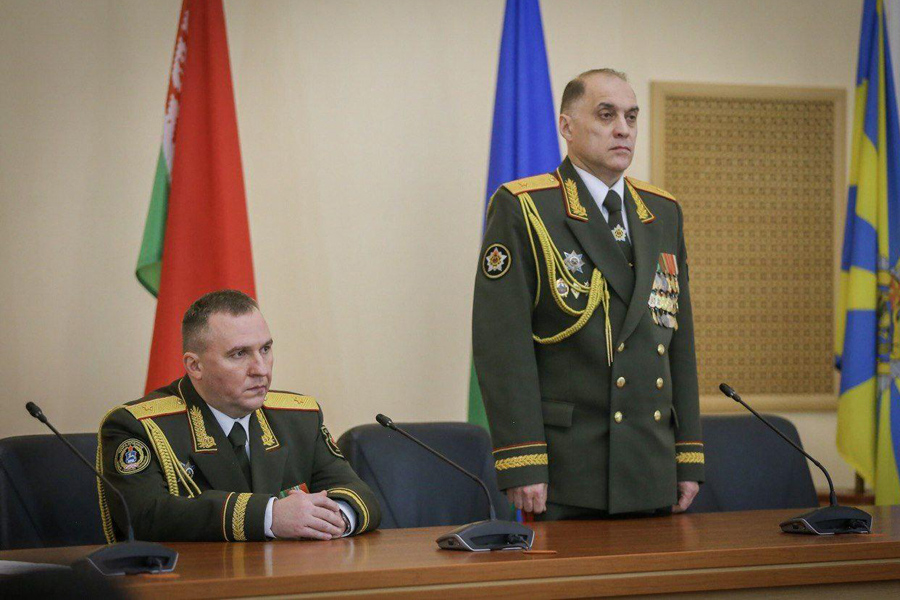

В свою очередь, выступая перед генералами и офицерами, глава военного ведомства отметил, что приоритеты в работе останутся прежними: «Считаю, что Вооруженные Силы отвечают тем требованиям, которые предъявляются Главой государства и народом, однако глубоко убежден, что нет предела совершенству. Основные усилия в своей деятельности сосредоточу на выполнении задач, поставленных Президентом».
Фото: Минобороны
Заметили ошибку? Пожалуйста, выделите её и нажмите Ctrl+Enter

